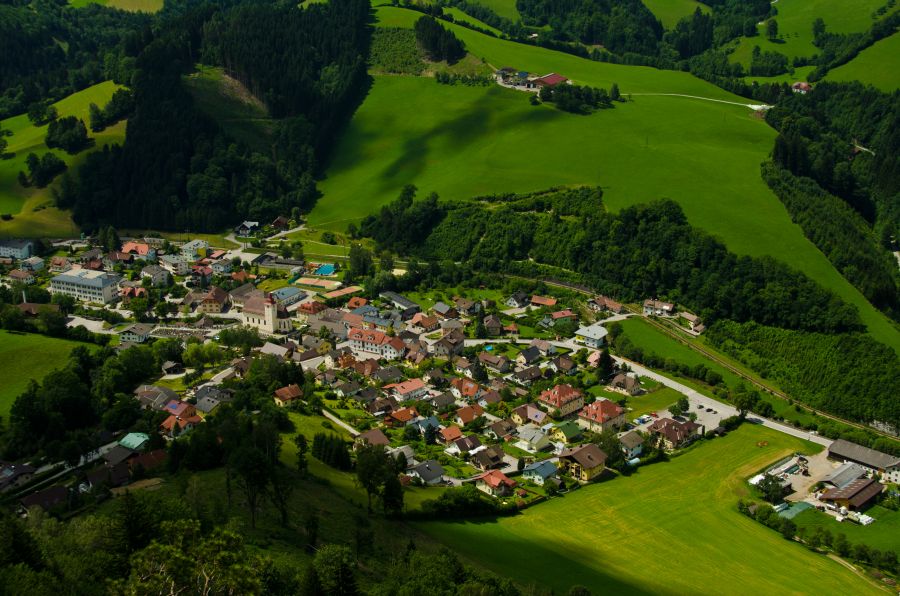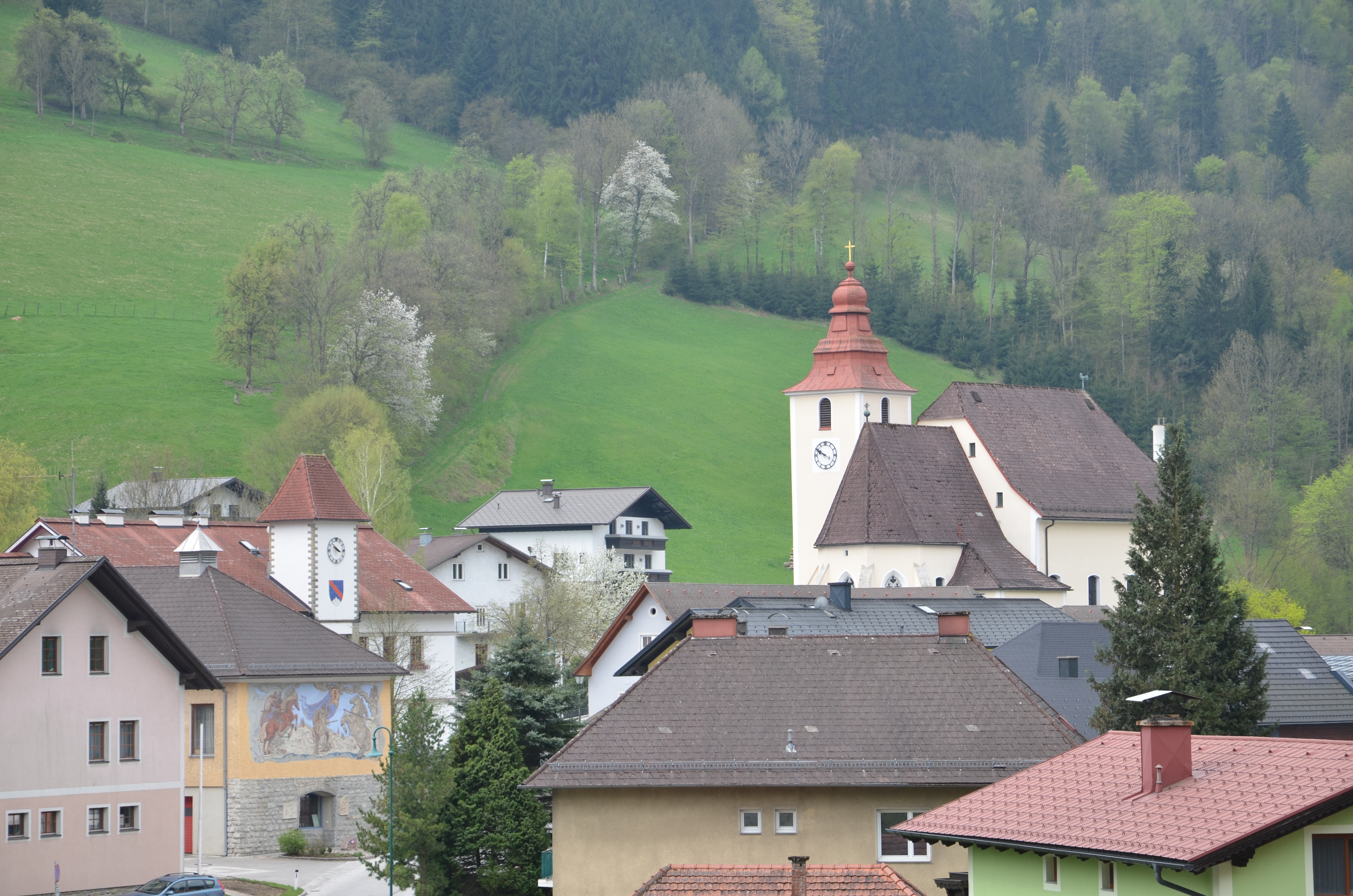Frankenfels
Frankenfels is a market town with 2047 inhabitants (as of 1 January 2013 ) in the district of Sankt Pölten- Land in Lower Austria.
- 2.1 Population development
- 3.1 Municipal Council
- 3.2 Mayor
- 3.3 Town twinning
- 5.1 traffic
- 5.2 Safety and Welfare
- 6.1 Structures
- 6.2 Nature attractions
- 6.3 Tourism and leisure facilities
- 6.4 Cultural Life
Geography
The municipality is located in the Most district in Lower Austria, in Pielachtal. The area of the municipality covers 56.11 square kilometers at the Pielach itself, on Natternbach and the White Stream, two of its left tributaries.
57.34 percent of the area is forested.
Community structure
The municipality includes the following 19 places (in brackets population as of 31 October 2011):
- Falkenstein Rottenberg (88 )
- Fischbachmühlrotte (48)
- Frankenfels (440 )
- Grasser Rottenberg (62 )
- Gstettengegend (23)
- Hofstadtgegend (206)
- Karrotte (23)
- Laubbach area (99 )
- Fief area (107 )
- Brand impact Rottenberg (154 )
- Ödrotte (54)
- Pernarotte (53)
- Pielachleitengegend (16)
- Rosenbühelrotte (226 )
- Taschlgrabenrotte (3)
- Deep grave rotting (132 )
- Transition Rottenberg (193 )
- White Castle area (62 )
- Wies Rottenberg (51 )
The municipality comprises the cadastral Frankenfels.
Zählsprengel are Frankenfels - central area ( Frankenfels, parts of Hofstadtgegend, fiefs area and Rosenbühelrotte ) and Frankenfels environment ( rest of the community ).
Neighboring communities
History
In the 11th century Bavarian settlers went cultivate the land below the Enns. This period also saw the settlement of the area around Frankenfels and the urbanization of the upper Pielach valley falls. The Bavarian colonialists met back then isolated on Slavic settlers, native names such as Aspergillus, Zigga Perna and others confirm this hypothesis.
By 1300, sold Konrad Sommerauer of Wallsee land ownership to Archduke Albrecht as the land around Franchenvels, today Frankenfels. In this document are already many field names that are today still noted in the cadastral plan shall be reported. Much of the still managed farms found in the land register of Wallsee from 1449 its first documentary mention. The division of the region into Rotten was founded in 1629th
1596/97 gathered the Puchenstubener host Christian Haller, many farmers from Frankenfels to fight against the imperial family around. The uprising, triggered by the unbearable tax burdens, was defeated after heavy fighting. Many have had it with their lives.
In the 16th and 17th centuries won Frankenfels, especially through the work of Weißenburger noble family Tattenbach, to economic and social importance. The award of the market right at Frankenfels in 1655 crowned these efforts. By 1630 the division was followed in the still standing in use classification of the bands, and regions. The house numbering and the first plans for cadastral folder ( Josefinischer land - after Joseph II named) were created 1770-1787.
With the opening of the second portion of the Mariazell Railway Frankenfels got a connection to the railway network.
Population Development
According to the results of the 2001 census, there were 2,187 inhabitants. In 1991, the market town of 2,118 inhabitants in 1981 and 2,026 in 1971, 1,989 inhabitants.
Policy
Municipal council
- ÖVP: 15
- SPÖ: 5
- FPÖ: 1
The seats parameters is outdated and obsolete!
In the council, there are a total of 21 seats after the municipal elections of 14 March 2010:
Mayor of the municipality is Größbacher Franz, Vice Mayor Henry plaster Lechner.
Mayor
- Anton Pögner, businessman, 1901-1906
- Leopold Again, mill owner, 1906-1918
- Josef Schagerl, farmer, 1918-1929
- Josef Niederer, farmer, 1929-1938
- Leopold Friewald, Teacher, 1938
- Franz Labner (* 1894), bailiff, 1938-1945
- Josef Niederer, farmer, 1945
- Franz Winter, farmer, 1945-1946
- Josef Niederer, farmer, 1946-1956
- Alois Fahrnberger, farmer, 1956-1965
- Franz Größbacher (1916-1999), municipal secretary, 1965-1987
- Friedrich Griesauer (* 1938), farmer, 1987-1999
- Ernst Lang Thaler ( b. 1941 ), Worker, 1999-2009
- Franz Größbacher (* 1957), municipal secretary, from 2009
Twinning
Frankenfels is a partner congregation of Hollstadt in Lower Franconia.
Capital of the municipality
Template: Infobox community part in Österreich/Wartung/Nebenboxf0f1f0f1
Municipal seat as well as the town is a market town Frankenfels. It is located about 32 kilometers in a straight line south-west of St. Pölten. It is situated in the municipal area, at about 460 m above sea level. A. Height in the valley of Snake Bach, the left-hand (western) side of the waters Pielach at Pielachgegend, and extends over slightly more than a kilometer bachab and upstream of the Church.
The village comprises about 120 buildings with about 460 inhabitants, which is good 1 /5 of the municipality 's population.
For Zählsprengel Frankenfels central area also includes almost all the Hofstadtgegend out of the valley, some places near houses of the feudal area, and the major chunk of Rosenbühelrotte valley. This includes the 230 buildings with about 900 inhabitants (2/5 of the municipality 's population), and corresponds to the Talsiedlungsgebiet at the bottom Natternbach.
Through the local area here run along the valley Pielachtal road ( B39 ) and Mariazell Railway, the city is served by the stop Frankenfels.
Grasser Rottenberg (O)
Stone, classified by Statistics Austria as scattered houses, referred to as the common stone - houses in the area objects sub - stone, Mitter- stone and the upper stone. The farms were called in Latin in 1300 as a super Lapide and shared only a few centuries later.
Economy and infrastructure
Non-agricultural work places there were in 2001, 71 agricultural and forestry holdings according to the 1999 survey 162 The number of persons employed at the residence was according to the 2001 census, 1,019. The employment rate in 2001 was 47.87 percent.
Traffic
Frankenfels is located on the Mariazell Railway. This rail line stops in the municipality in the stops Schwarzenbach an der Pielach Hofstadtgegend, Frankenfels, the operating station Laubenbachmühle as well as in the stop boding at Pernarotte. Stops White Castle and Unterbuchberg were hired former already in the 1920s, temptation recently. The track is out on Frankenfels municipality through several tunnels and bridges.
Bahnhof Schwarzenbach an der Pielach
Station Laubenbachmühle
At the higher-ranking road network Frankenfels is served by the B39 ( Pielachtal road). In addition, still lead nationally important state roads over white castle and Plankenstein after Texing, as well as Schwarzenbach an der Pielach and Pielachtaler Gscheid to Türnitz. There are also links to hit the ground and to St. Gotthard.
Safety and social
Frankenfels has a practical doctor in private medicine cabinet as well as a specialist in dental and maxillofacial surgery. Since 1961, a local site of the Workers' Samaritan Federation exists. There are for the people of Frankenfels and the immediate area four rescue vehicles in use (as of 2011 ).
There are also the people help in Frankenfels.
In Frankenfels since 1883, there is a volunteer fire department, said due to the large municipal area and the resulting exposed location of farms since 1938 is a locally stepped train at the fire station White Castle. Since 1993 there is also a fire department in Frankenfels youth.
Culture and sights
Structures
- Castle White Castle
- Parish Frankenfels
- Schwabeck Cross ( actually already on Texinger area )
- Grasser mill
- Anna Cross
- Steinschalerdörfl
The Anna Cross
Natural attractions
- Nixhöhle
- Falkenstein Wall
- Pigeons gorge
Tourism and recreational facilities
- Bergbauernmuseum House Stone
- Mariazellerbahn
- Frankenfels Tree Circle
In addition to marked walking and hiking trails following outdoor activities are in Frankenfels nor offered: The climbing areas in which up to 80 m high stone wall Falk, the Schrambach, while Aspergillus and when Anglbach; Nature trails; Mountain bike trails; Natural slopes; Outdoor pool Frankenfels; Beach volleyball court; game reserve
Cultural life
As in many other communities in the region, the cultural life is strongly influenced by the activity of local clubs and organizations.
- Costume Musikverein Frankenfels 1924 emerged from the chapel Hölzl and founded in 1959.
- Musikverein Ötscherland
- The rural youth Frankenfels regularly organizes the so- called farmers' theater in franken felser restaurants.
There will be annual balls, Wednesday events with local specialties and tent festivals clubs and local organizations instead. (eg the fire festivals) regularly find foot pilgrimages to Mariazell instead (via Schwarzenbach an der Pielach ) and St. Gotthard on the Schwabeck Cross in the deep grave rotting in Weissbach.
The football club Union Raika Frankenfels, founded in 1980, is eligible to play in the 2nd class foothills of the Alps. The shooting club Frankenfels, founded in 1965, is eligible to play in the national league. In addition, several other sporting activities such as winter sports, clubs and clubs are organized.
Personalities
- Josepha werndl (* 1806), mother of Joseph werndl
- John Fahrngruber (1845-1901), professor of theology, local historian, art historian and founder of the St. Pölten Diocese Museum
- Hugo Jury (1887-1945), community physician from 1913 to 1919 and later Nazi politician
- Franz Niederer (1903-1948), musician, founder of several music groups and victims of a rampage
- Franz Größbacher (1916-1999), former mayor, fire chief and district chairman of the Lower Austrian Blasmusikverbandes
- Anton Wicho (1924-1960), alpine skier
- Anton Gollubitsch (1928-1980), Skibob - Senior World Champion 1971
- Bernhard Gamsjager ( b. 1949 ), author of several local and regional historical books, Theodor Körner Prize winner in 1983 and Culture prize winner of the northeast in 1989 and 2010.
- Ernst Lang Thaler ( b. 1965 ), historian, university professor, Culture winners of the country's northeast in 2004 and 2005
- Martin Neubauer ( b. 1973 ), chess Vice State Champion 2005 and former Austrian Federal Youth chess coach
- Josef Kugler ( born 1984 ), cyclist
- Sascha Fahrngruber (* 1989), former football player in the First League ( SKN St. Pölten) and now with the third division SKU Amstetten










